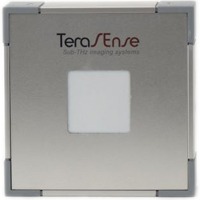The detectors are fabricated with a GaAs high-mobility heterostructure in the standard semiconductor cycle using conventional optical lithography. The imaging sensor is manufactured on a single wafer. That process ensures high homogeneity and reproducibility of the plasmonic detector parameters (pixel-to-pixel deviation responsivity is within a 20- percent range). Each detector unit has a room-temperature responsivity up to 50 kV/W with read-out circuitry and noise-equivalent power of 1 nW/ in the frequency range 10 GHz — 1 THz. The detection mechanism is based on excitation of plasma oscillations in two-dimentional electron system with subsequent rectification. The rectification takes place on a special defects made in the electron system.
These terahertz cameras are active detecting devices, and require an external THz source. We offer sub-terahertz wave sources based on IMPATT technology. All TERA-series THz imaging cameras employ the same type of detectors with identical capabilities and spatial resolution. The difference between our models lies in the number of pixels in their sensor arrays and their effective imaging area


